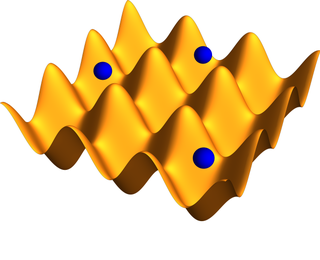
In condensed matter physics, a Bose–Einstein condensate (BEC) is a state of matter that is typically formed when a gas of bosons at very low densities is cooled to temperatures very close to absolute zero. Under such conditions, a large fraction of bosons occupy the lowest quantum state, at which microscopic quantum-mechanical phenomena, particularly wavefunction interference, become apparent macroscopically. More generally, condensation refers to the appearance of macroscopic occupation of one or several states: for example, in BCS theory, a superconductor is a condensate of Cooper pairs. As such, condensation can be associated with phase transition, and the macroscopic occupation of the state is the order parameter.

In condensed matter physics, a supersolid is a spatially ordered material with superfluid properties. In the case of helium-4, it has been conjectured since the 1960s that it might be possible to create a supersolid. Starting from 2017, a definitive proof for the existence of this state was provided by several experiments using atomic Bose–Einstein condensates. The general conditions required for supersolidity to emerge in a certain substance are a topic of ongoing research.

The lambda point is the temperature at which normal fluid helium makes the transition to superfluid helium II. The lowest pressure at which He-I and He-II can coexist is the vapor−He-I−He-II triple point at 2.1768 K (−270.9732 °C) and 5.0418 kPa (0.049759 atm), which is the "saturated vapor pressure" at that temperature. The highest pressure at which He-I and He-II can coexist is the bcc−He-I−He-II triple point with a helium solid at 1.762 K (−271.388 °C), 29.725 atm (3,011.9 kPa).

An optical lattice is formed by the interference of counter-propagating laser beams, creating a spatially periodic polarization pattern. The resulting periodic potential may trap neutral atoms via the Stark shift. Atoms are cooled and congregate at the potential extrema. The resulting arrangement of trapped atoms resembles a crystal lattice and can be used for quantum simulation.
The Bose–Hubbard model gives a description of the physics of interacting spinless bosons on a lattice. It is closely related to the Hubbard model that originated in solid-state physics as an approximate description of superconducting systems and the motion of electrons between the atoms of a crystalline solid. The model was introduced by Gersch and Knollman in 1963 in the context of granular superconductors. The model rose to prominence in the 1980s after it was found to capture the essence of the superfluid-insulator transition in a way that was much more mathematically tractable than fermionic metal-insulator models.
In condensed matter physics, an ultracold atom is an atom with a temperature near absolute zero. At such temperatures, an atom's quantum-mechanical properties become important.
Markus Greiner is a German physicist and Professor of Physics at Harvard University.
John David Reppy is a physicist and the John L. Wetherill Professor of Physics Emeritus at Cornell University. He studies the quantum properties of superfluids such as helium.

Superfluidity is the characteristic property of a fluid with zero viscosity which therefore flows without any loss of kinetic energy. When stirred, a superfluid forms vortices that continue to rotate indefinitely. Superfluidity occurs in two isotopes of helium when they are liquefied by cooling to cryogenic temperatures. It is also a property of various other exotic states of matter theorized to exist in astrophysics, high-energy physics, and theories of quantum gravity. The theory of superfluidity was developed by Soviet theoretical physicists Lev Landau and Isaak Khalatnikov.

In condensed matter physics, a time crystal is a quantum system of particles whose lowest-energy state is one in which the particles are in repetitive motion. The system cannot lose energy to the environment and come to rest because it is already in its quantum ground state. Time crystals were first proposed theoretically by Frank Wilczek in 2012 as a time-based analogue to common crystals – whereas the atoms in crystals are arranged periodically in space, the atoms in a time crystal are arranged periodically in both space and time. Several different groups have demonstrated matter with stable periodic evolution in systems that are periodically driven. In terms of practical use, time crystals may one day be used as quantum computer memory.
Immanuel Bloch is a German experimental physicist. His research is focused on the investigation of quantum many-body systems using ultracold atomic and molecular quantum gases. Bloch is known for his work on atoms in artificial crystals of light, optical lattices, especially the first realization of a quantum phase transition from a weakly interacting superfluid to a strongly interacting Mott insulating state of matter.

Tilman Esslinger is a German experimental physicist. He is Professor at ETH Zurich, Switzerland, and works in the field of ultracold quantum gases and optical lattices.
Warwick Bowen is an Australian quantum physicist and nanotechnologist at The University of Queensland. He leads the Quantum Optics Laboratory, is Director of the UQ Precision Sensing Initiative and is one of three Theme Leaders of the Australian Centre for Engineered Quantum Systems.
Cindy A. Regal is an American experimental physicist most noted for her work in quantum optics; atomic, molecular, and optical physics (AMO); and cavity optomechanics. Regal is an associate professor in the Department of Physics at the University of Colorado and JILA Fellow; and a Fellow of the American Physical Society (APS).

Hidetoshi Katori is a Japanese physicist and professor at the University of Tokyo best known for having invented the magic wavelength technique for ultra precise optical lattice atomic clocks. Since 2011, Katori is also Chief Scientist at the Quantum Metrology Lab, RIKEN.

Phase separation is the creation of two distinct phases from a single homogeneous mixture. The most common type of phase separation is between two immiscible liquids, such as oil and water. This type of phase separation is known as liquid-liquid equilibrium. Colloids are formed by phase separation, though not all phase separations forms colloids - for example oil and water can form separated layers under gravity rather than remaining as microscopic droplets in suspension.
Katelin Schutz is an American particle physicist known for using cosmological observations to study dark sectors, that is new particles and forces that interact weakly with the visible world. She was a NASA Einstein Fellow and Pappalardo Fellow in the MIT Department of Physics and is currently an assistant professor of physics at McGill University.

Jessica Esquivel is a Black Mexican and American physicist and science communicator, working at the Muon g-2 particle physics experiment at Fermilab. She is an advocate for gender and racial equity in science, and a lead organiser of #BlackInPhysics, a campaign to recognize and amplify the work of Black physicists worldwide. She was also selected as an AAAS IF/THEN Ambassador in 2019.
Eileen Gonzales is an American astrophysicist and postdoctoral fellow at the Department of Astronomy at Cornell University, where her research focuses on exoplanets and brown dwarfs. She is also a co-founder and lead organizer of #BlackInPhysics, a campaign to recognize and celebrate Black physicists and amplify their work.

Monika Aidelsburger is a German quantum physicist, Professor and Group Leader at the Ludwig Maximilian University of Munich. Her research considers quantum simulation and ultra cold atomic gases trapped in optical lattices. In 2021, she was awarded both the Alfried-Krupp-Förderpreis and Klung Wilhelmy Science Award.









